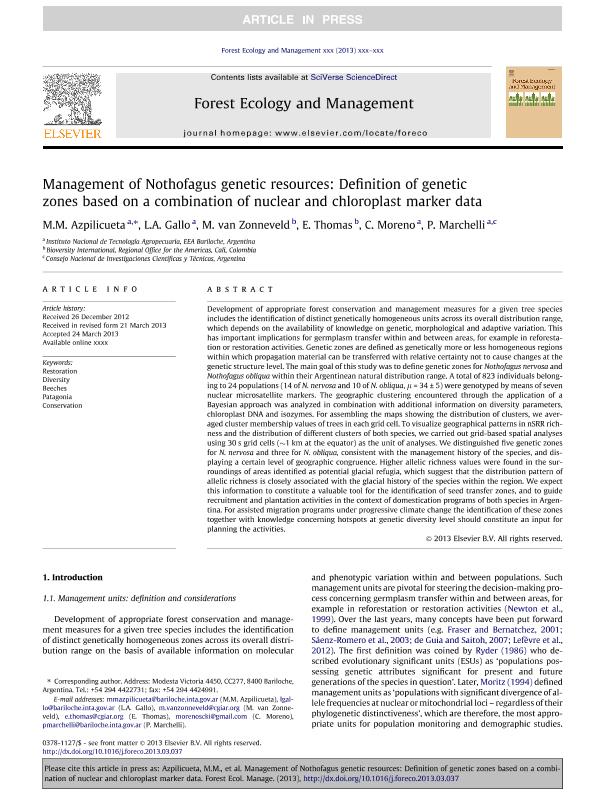Mostrar el registro sencillo del ítem
dc.contributor.author
Azpilicueta, María Marta

dc.contributor.author
Gallo, L. A.
dc.contributor.author
van Zonneveld, M.
dc.contributor.author
Thomas, E.
dc.contributor.author
Moreno, Angela Carolina

dc.contributor.author
Marchelli, Paula

dc.date.available
2020-04-17T20:49:52Z
dc.date.issued
2013-03
dc.identifier.citation
Azpilicueta, María Marta; Gallo, L. A.; van Zonneveld, M.; Thomas, E.; Moreno, Angela Carolina; et al.; Management of Nothofagus genetic resources: Definition of genetic zones based on a combination of nuclear and chloroplast marker data; Elsevier Science; Forest Ecology and Management; 302; 3-2013; 414-424
dc.identifier.issn
0378-1127
dc.identifier.uri
http://hdl.handle.net/11336/102992
dc.description.abstract
Development of appropriate forest conservation and management measures for a given tree species includes the identification of distinct genetically homogeneous units across its overall distribution range, which depends on the availability of knowledge on genetic, morphological and adaptive variation. This has important implications for germplasm transfer within and between areas, for example in reforestation or restoration activities. Genetic zones are defined as genetically more or less homogeneous regions within which propagation material can be transferred with relative certainty not to cause changes at the genetic structure level. The main goal of this study was to define genetic zones for Nothofagus nervosa and Nothofagus obliqua within their Argentinean natural distribution range. A total of 823 individuals belonging to 24 populations (14 of N. nervosa and 10 of N. obliqua, μ= 34 ± 5) were genotyped by means of seven nuclear microsatellite markers. The geographic clustering encountered through the application of a Bayesian approach was analysed in combination with additional information on diversity parameters, chloroplast DNA and isozymes. For assembling the maps showing the distribution of clusters, we averaged cluster membership values of trees in each grid cell. This allowed us to distinguish five genetic zones for N. nervosa and three for N. nervosa. The identified genetic zones were consistent with the management history of the species, and display a certain level of geographic congruence. To visualize geographical patterns in nSRR richness and the distribution of different clusters of both species, we carried out grid-based spatial analyses using 30 seconds grid cells (~1 km at the equator) as the unit of analyses. We observed higher allelic richness values in the surroundings of areas identified as potential glacial refuges, which suggest that the distribution pattern of allelic richness is closely associated with the glacial history of the species within the region. We expect this information to constitute a valuable tool for the identification of seed transfer zones, and to guide recruitment and plantation activities in the context of domestication programs of both species in Argentina. For migration assisted programs under progressive climate change the identification of these zones together with knowledge concerning hotspots at genetic diversity level should constitute an input for planning the activities.
dc.format
application/pdf
dc.language.iso
eng
dc.publisher
Elsevier Science

dc.rights
info:eu-repo/semantics/openAccess
dc.rights.uri
https://creativecommons.org/licenses/by-nc-sa/2.5/ar/
dc.subject
RESTORATION
dc.subject
DIVERSITY
dc.subject
BEECHES
dc.subject
PATAGONIAN
dc.subject
CONSERVATION
dc.subject.classification
Otras Ciencias Naturales y Exactas

dc.subject.classification
Otras Ciencias Naturales y Exactas

dc.subject.classification
CIENCIAS NATURALES Y EXACTAS

dc.subject.classification
Otras Ciencias de la Tierra y relacionadas con el Medio Ambiente

dc.subject.classification
Ciencias de la Tierra y relacionadas con el Medio Ambiente

dc.subject.classification
CIENCIAS NATURALES Y EXACTAS

dc.title
Management of Nothofagus genetic resources: Definition of genetic zones based on a combination of nuclear and chloroplast marker data
dc.type
info:eu-repo/semantics/article
dc.type
info:ar-repo/semantics/artículo
dc.type
info:eu-repo/semantics/publishedVersion
dc.date.updated
2020-03-16T20:01:25Z
dc.journal.volume
302
dc.journal.pagination
414-424
dc.journal.pais
Países Bajos

dc.journal.ciudad
Amsterdam
dc.description.fil
Fil: Azpilicueta, María Marta. Instituto Nacional de Tecnología Agropecuaria. Centro Regional Patagonia Norte. Estación Experimental Agropecuaria San Carlos de Bariloche; Argentina
dc.description.fil
Fil: Gallo, L. A.. Instituto Nacional de Tecnología Agropecuaria. Centro Regional Patagonia Norte. Estación Experimental Agropecuaria San Carlos de Bariloche; Argentina
dc.description.fil
Fil: van Zonneveld, M.. Bioversity International. Regional Office for the Americas; Colombia
dc.description.fil
Fil: Thomas, E.. Bioversity International. Regional Office for the Americas; Colombia
dc.description.fil
Fil: Moreno, Angela Carolina. Instituto Nacional de Tecnología Agropecuaria. Centro Regional Patagonia Norte. Estación Experimental Agropecuaria San Carlos de Bariloche; Argentina. Consejo Nacional de Investigaciones Científicas y Técnicas; Argentina
dc.description.fil
Fil: Marchelli, Paula. Consejo Nacional de Investigaciones Científicas y Técnicas; Argentina. Instituto Nacional de Tecnología Agropecuaria. Centro Regional Patagonia Norte. Estación Experimental Agropecuaria San Carlos de Bariloche; Argentina
dc.journal.title
Forest Ecology and Management

dc.relation.alternativeid
info:eu-repo/semantics/altIdentifier/url/http://www.sciencedirect.com/science/article/pii/S0378112713001849
dc.relation.alternativeid
info:eu-repo/semantics/altIdentifier/doi/http://dx.doi.org/10.1016/j.foreco.2013.03.037
Archivos asociados
